PEAK-System PCAN-Repeater DR Operating instructions
- Type
- Operating instructions

CAN Repeater for the Decoupling of
Bus Segments
User Manual
PCAN-Repeater DR
Document version 1.3.1 (2017-02-10)

PCAN-Repeater DR – User Manual
2
Relevant products
Product Name Model Part Number
PCAN-Repeater DR Industry IPEH-004038
All product names mentioned in this document may be the trademarks or registered
trademarks of their respective companies. They are not explicitly marked by „™“and
„®“.
© 2017 PEAK-System Technik GmbH
PEAK-System Technik GmbH
Otto-Roehm-Straße 69
64293 Darmstadt
Germany
Phone: +49 (0)6151 8173-20
Fax: +49 (0)6151 8173-29
www.peak-system.com
info@peak-system.com
Doc
ument version 1.3.1 (2017-02-10)

PCAN-Repeater DR – User Manual
3
Contents
1 Introduction 4
1.1 Properties at a Glance 4
1.2 Prerequisites for Operation 5
1.3 Scope of Supply 5
2 Connectors 6
2.1 CAN1/CAN2 6
2.2 Power Supply 6
3 Operation 7
3.1 Putting Into Operation 7
3.1.1 Signal Delay 7
3.1.2 Busload and Error Display 8
3.2 Status LEDs 9
3.3 CAN Termination 9
3.4 Listen-only Mode 11
3.5 Application Examples 13
3.5.1 Decoupling of Two Bus Segments 13
3.5.2 Implementation of a Stub Line 14
4 Technical Specifications 16
Appendix A CE Certificate 18
Appendix B Dimension Drawing 19

PCAN-Repeater DR – User Manual
4
1 Introduction
The PCAN-Repeater DR creates a connection between two High-
speed CAN busses with galvanic isolation of up to 5 kV (DC). Both
CAN channels are decoupled from each other and from the power
supply. All message traffic including error frames is forwarded 1:1
between both channels, if necessary, in one direction only. The
PCAN-Repeater DR behaves passively and is transparent from the
perspective of the CAN bus. LEDs display the current bus status.
With its DIN rail casing and extended temperature range support,
this module is suitable for use in an industrial environments.
Due to the CAN protocol, the maximum length of a CAN bus
depends on the bit rate. Therefore, a bus cannot be extended with
the PCAN-Repeater DR. The physical total length of the CAN bus is
reduced with each built-in PCAN-Repeater DR according to its signal
delay.
1.1 Properties at a Glance
Two High-speed CAN channels (ISO 11898-2)
Bit rates up to 1 Mbit/s
Compliant with CAN specifications 2.0A (11-bit ID)
and 2.0B (29-bit ID)
NXP PCA82C251 CAN transceiver
Connections for CAN and power supply via 4-pin screw terminal
block (Phoenix)
LEDs display CAN bus load and CAN errors
Each CAN channel can be selectively terminated

PCAN-Repeater DR – User Manual
5
Galvanic isolation up to 5 kV (DC) according to IEC 60601-1,
between both CAN channels and between CAN and power
supply
Listen-only mode optionally switchable for CAN channel 1 or
CAN channel 2
Plastic casing (width: 22,5 mm) for mounting on a DIN rail
(DIN EN 60715 TH35)
Voltage supply from 8 to 30 V
Extended operating temperature range -40 to 85 °C
(-40 to 185 °F)
1.2 Prerequisites for Operation
Voltage supply source in the range of 8 to 30 V DC
1.3 Scope of Supply
PCAN-Repeater DR in DIN rail plastic casing
3 mating connectors (Phoenix, Type: MSTB 2,5/4-ST BK) for
power supply and CAN connections
Manual in PDF format

PCAN-Repeater DR – User Manual
6
2 Connectors
2.1 CAN1/CAN2
The CAN connectors are located on the upper side of the casing.
Figure 1: CAN socket
Pin Assignment
1 CAN-High
2 CAN-Low
3 CAN-GND
4 CAN-Shield
1
2.2 Power Supply
The connection for the power supply is located on the lower side of
the casing.
Figure 2: Power socket
Pin Assignment
1 GND
2 not connected
3 Vbat (8 - 30 V DC)
4 Shield (DIN rail potential)
1
Capacitive connection (5 kV) to supply shield (DIN rail potential)

PCAN-Repeater DR – User Manual
7
3 Operation
3.1 Putting Into Operation
Do the following to install the PCAN-Repeater DR into your CAN
network:
1. Mount the PCAN-Repeater DR at the appropriate position on
the DIN rail by placing it at the DIN rail and snapping it to
the bottom.
2. Connect each of the two CAN ports with the corresponding
CAN network. Note that the two CAN busses must have the
same
bit rates.
3. Connect the PCAN-Repeater DR to a suitable power supply
(8 - 30 V DC).
The PCAN-Repeater DR now forwards the CAN messages 1 to 1.
3.1.1 Signal Delay
T
he PCAN-Repeater DR has a transit time delay of 115 ns. This
corresponds to a cable length of 23 m. Therefore, you should con-
sider the dependence of the maximum length of a CAN bus on the
bit rate at the installation of the Repeater. The following table shows
the maximum possible CAN bus length at different bit rates:

PCAN-Repeater DR – User Manual
8
Bit rate Bus length Bus length with Repeater
1 Mbit/s 40 m 17 m
500 kbit/s 110 m 87 m
250 kbit/s 240 m 217 m
125 kbit/s 500 m 477 m
50 kbit/s 1.3 km
20 kbit/s 3.3 km
10 kbit/s 6.6 km
5 kbit/s 13.0 km
For small bit rates, the
delay of the Repeater can
be neglected.
The listed values have been calculated on the basis of an idealized
system and can differ from reality
Note: Due to the CAN protocol, the maximum length of a CAN
bus depends on the bit rate. Therefore, a bus cannot be exten-
ded with the PCAN-Repeater DR. The physical total length of
the CAN bus is reduced with each built-in PCAN-Repeater DR
according to its signal delay.
3.1.2 Busload and Error Display
F
or the bus load and error display the use of standard bit rates is
provided. As soon as the adapter is successfully put into operation
in a network, the adapter runs automatic bit rate detection. As long
as no bit rate is detected and for the duration of the detection the
traffic LED is on, colored orange. After a successful detection the
bus load and errors are displayed with the traffic and error LEDs.
Details can be found in the following chapter.
The bus load and error display are supported for the following bit
rates:
20 kbit/s, 33.3 kbit/s, 47.6 kbit/s, 50 kbit/s, 83.3 kbit/s, 95.2 kbit/s,
100 kbit/s, 125 kbit/s, 200 kbit/s, 250 kbit/s, 500 kbit/s, 800 kbit/s,
1 Mbit/s

PCAN-Repeater DR – User Manual
9
3.2 Status LEDs
The PCAN-Repeater DR has three status LEDs that represent the
following conditions:
Upper LED Status Meaning
Error Red flashing Communication error
(error frames)
Middle LED Status Meaning
Orange on Bit rate detection is performed
or no standard bit rate is
detected
OFF No CAN communication
Green slow blinking (2 Hz) Bus load > 0 - 19 %
Green quick blinking (4 Hz) Bus load 20 - 49 %
Orange slow blinking (2 Hz) Bus load 50 - 79 %
Traffic
Orange quick blinking (4 Hz) Bus load 80 - 100 %
Lower LED Status Meaning
Power Green on Power supply is on
Note: The display of the error and traffic LEDs refers always to
the CAN bus that is connected to CAN channel 1 (only relevant
for the listen-only mode).
3.3 CAN Termination
The termination for each CAN channel can be separately activated
by a switch on the board. At delivery the termination is switched on.
A High-speed CAN bus (ISO 11898-2) must be terminated on both
ends with 120 Ohms. Otherwise disturbances may arise.

PCAN-Repeater DR – User Manual
10
If a connected CAN bus is terminated, deactivate the termination
on the Repeater. If a CAN bus is not terminated correctly, activ-
ate the internal termination for the appropriate channel. Proceed
as follows to switch the termination on or off:
Important note: Before opening the adapter unplug the power
supply.
1. Open the plastic casing by slightly pushing the latches at the
top behind the CAN connectors and at the bottom behind
the power connector, e.g. with a flat tip screwdriver.
2. Now you can pull out the front part of the casing with the
board.
Figure 3 shows the positions of the respective switches of
t
he PCAN-Repeater DR on the board.
Figure 3: Termination per CAN channel
Change the termination settings for the CAN channels with the
switches on the board. The affiliations and settings are labeled on
the board.

PCAN-Repeater DR – User Manual
11
For the assembly of the PCAN-Repeater DR slide the board inclu-
ding the front part back into the plastic casing and press the casing
together (the latches click in).
3.4 Listen-only Mode
The listen-only mode is optionally switched on for the CAN channel
1 or the CAN channel 2. If the listen-only mode for CAN-channel 1 is
activated the participants on this bus can receive the messages
from CAN channel 2, but no data (and also no Acknowledge) is
transferred from CAN channel 1 to CAN channel 2. At delivery of the
PCAN-Repeater DR the listen-only mode is switched off.
Note: The listen-only mode should be enabled only for one
CAN channel. If both CAN channels are running in listen-only
mode the complete Repeater DR function is disabled.
Proceed as follows to switch the listen-only mode on or off:
Important note: Before opening the adapter unplug the power
supply.
1. Open the casing by slightly pushing the latches at the top
behind the CAN connectors and at the bottom behind the
power connector, e.g. with a flat tip screwdriver.
2. Now you can pull out the front part of the casing with the
board.
Figure 4 shows the positions of the respective switches of
t
he PCAN-Repeater DR on the board.

PCAN-Repeater DR – User Manual
12
Figure 4: Listen-only mode per CAN channel
To turn on the listen-only mode for the CAN channels, switch S4 to
Listen only for each CAN channel. The settings of the switch are
labeled on the board.
For the assembly of the PCAN-Repeater DR slide the board inclu-
ding the front part back into the plastic casing and press the casing
together (the latches click in).

PCAN-Repeater DR – User Manual
13
3.5 Application Examples
This section describes two application examples for the PCAN-
Repeater DR:
Decoupling of two Bus Segments (below)
Implementation of a Stub Line (on page 14)
Note: The PCAN-Repeater DR cannot be used to extend the
length of a CAN bus in order to exceed the maximum length.
3.5.1 Decoupling of Two Bus Segments
The PCAN
-Repeater DR is used to establish a galvanic isolation
between two bus segments. If a connected CAN bus is completely
terminated, deactivate the termination on the Repeater. If a CAN
bus is not completely terminated, activate the internal termination
for the appropriate channel. Note that a CAN bus always must be
terminated with 120 Ohms at both ends.
With the switchable listen-only mode, the direction of message
forwarding can be set up as required. With a suitable bit rate (see
section 3.1.2 on page 8) the bus load and errors will be displayed
w
ith the traffic and error LEDs.

PCAN-Repeater DR – User Manual
14
Figure 5: Decoupling of two CAN busses
CAN 1 Status CAN 2 Status
Termination
On, at a not
terminated CAN bus
Off, at a completely
terminated CAN bus
Termination
On, at a not
terminated CAN bus
Off, at a completely
terminated CAN bus
Listen-only
mode
Optional On or Off Listen-only
mode
Optional On or Off
3.5.2 Implementation of a Stub Line
The PCAN-Repeater DR is used to establish a physical coupling of
two or more segments of a CAN network. With a tap on a CAN bus
a long stub line can be implemented with several participants.
If the CAN bus B is not completely terminated, activate the internal
termination for CAN channel 1. Note that a CAN bus always must be
terminated with 120 Ohms at both ends. As this tap on the CAN bus
A is not a cable end, deactivate the termination on CAN channel 2.
With the switchable listen-only mode, the direction of message
forwarding can be set up as required. With a suitable bit rate (see

PCAN-Repeater DR – User Manual
15
section 3.1.2 on page 8) the bus load and error will be displayed
with the traffic and error LEDs.
Figure 6: Implementation of a stub line
CAN 1 Status CAN 2 Status
Termination
On, at a not
terminated CAN bus
Off, at a completely
terminated CAN bus
Termination
Off, a termination
may only be done
on the cable ends of
a CAN bus
Listen-only
mode
Optional On or Off Listen-only
mode
Optional On or Off

PCAN-Repeater DR – User Manual
16
4 Technical Specifications
Connectors
CAN 2 x Phoenix connector
2
4-pin
Power Phoenix connector 4-pin
CAN
Specification ISO 11898-2; High-speed CAN
2.0A (standard format) and 2.0B (extended format)
Bit rates 5 kbit/s - 1 Mbit/s
Transceiver NXP PCA82C251
Galvanic isolation Up to 5 kV DC or 3.5 kV AC,
between both CAN channels
and between CAN and power supply
Termination 120 Ohm, switchable for each CAN channel, at
delivery activated
Listen-only mode Switchable for CAN channel 1 or 2
Transmit time delay 115 ns (equals 23 m cable length)
Power supply
Supply voltage 8 - 30 V DC
Power consumption 70 mA at 9 V
30 mA at 24 V
Measures
Size 22,5 x 99 x 114,5 mm (W x H x D)
See also dimension drawing
in Appendix B on page 19
Weight 96 g
2
Phoenix connector, type MSTB 2,5/4-ST BK, order no. 1756298,
www.phoenixcontact.com

PCAN-Repeater DR – User Manual
17
Environment
Operating temperature -40 - 85 °C (-40 - 185 °F)
Temperature for storage and
transport
-40 - 100 °C (-40 - 212 °F)
Relative humidity 15 - 90 %, not condensing
EMC Directive 2014/30/EU
EN 61326-1:2013-07
Extended interference resistance:
IEC61000-4-6 (10 V eff.)
IEC61000-4-3 (20 V/m)
Security IEC 60601-1
Ingress protection (IEC 60529) IP20

PCAN-Repeater DR – User Manual
18
Appendix A CE Certificate

PCAN-Repeater DR – User Manual
19
Appendix B Dimension Drawing
The figure doesn’t show the actual size of the product.
-
 1
1
-
 2
2
-
 3
3
-
 4
4
-
 5
5
-
 6
6
-
 7
7
-
 8
8
-
 9
9
-
 10
10
-
 11
11
-
 12
12
-
 13
13
-
 14
14
-
 15
15
-
 16
16
-
 17
17
-
 18
18
-
 19
19
PEAK-System PCAN-Repeater DR Operating instructions
- Type
- Operating instructions
Ask a question and I''ll find the answer in the document
Finding information in a document is now easier with AI
Related papers
-
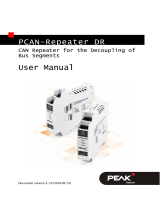 PEAK-System PCAN-Repeater DR Operating instructions
PEAK-System PCAN-Repeater DR Operating instructions
-
PEAK PCAN-PC/104 User manual
-
PEAK IPEH-002093 User manual
-
PEAK PCAN-ExpressCard 34 User manual
-
 PEAK-System PCAN-PC Card Operating instructions
PEAK-System PCAN-PC Card Operating instructions
-
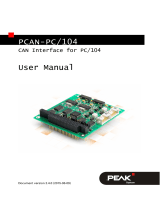 PEAK-System PCAN-PC/104 Operating instructions
PEAK-System PCAN-PC/104 Operating instructions
-
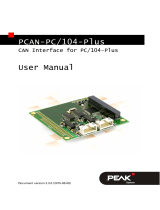 PEAK-System PCAN-PC/104-Plus Operating instructions
PEAK-System PCAN-PC/104-Plus Operating instructions
-
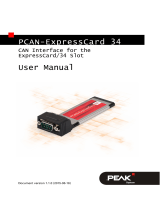 PEAK-System PCAN-ExpressCard 34 Operating instructions
PEAK-System PCAN-ExpressCard 34 Operating instructions
-
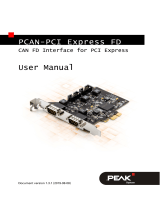 PEAK-System PCAN-PCI Express FD Operating instructions
PEAK-System PCAN-PCI Express FD Operating instructions
-
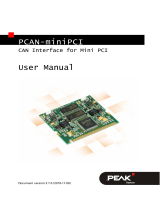 PEAK-System PCAN-miniPCI Operating instructions
PEAK-System PCAN-miniPCI Operating instructions
Other documents
-
PEAK IPEH-002093 User manual
-
PEAK IPEH-002093 User manual
-
PEAK PCAN-PC/104 Series User manual
-
PEAK IPEH-004026 User manual
-
PEAK PCAN-Ethernet Gateway DR User manual
-
PEAK PCAN-Wireless Gateway DR User manual
-
PEAK PCAN-USB Pro FD User manual
-
PEAK USB to CAN Interface User manual
-
PEAK IPEH-002066 User manual
-
PEAK IPEH-003040 User manual

























